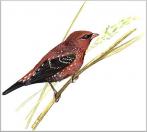Red Avadavat - Amandava amandava
A rare case of an "alien" species among the marshland ornithofauna, the Red Avadavat has recently installed itself in some wetland areas of Spain, Portugal and Italy.
In nuptial dress, the male is a beautiful carmine red, with wings and underparts dotted with white. The female and male winter plumage is a rather uniform grey-brown (slightly paler on the underparts) and without dotting.
The red mark on the rump, near the tail, is useful for identification in winter. It beats its wings very quickly in flight, advancing in an undulating course and often emitting a sharp call.
A very gregarious seed eating species, it is associated with marshland vegetation but locally it also occurs in areas of reclaimed cultivated land. It builds a large ellipsoidal nests with a side opening by rather coarsely weaving the stalks and leaves of marshland grasses.
In Europe it nests late, between August and October. Originally from India, the Red Avadavat has long been reared over almost all of the world as an ornamental species.
Although it only recently appeared in the wild in Italy, which happened in Tuscany in the second half of the '80s, it seems to destined to become the most abundant resident in the marshlands it has colonised.
At present is occurs in the Bientina Marshes, Lake Sibolla and the Fucecchio Marshes.




